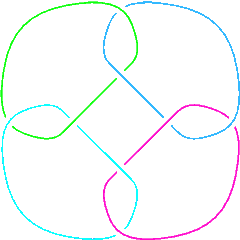The Multivariable Alexander Polynomial: Difference between revisions
DrorsRobot (talk | contribs) No edit summary |
No edit summary |
||
| Line 46: | Line 46: | ||
out= <nowiki>t1 t3 - t2 t3 - t1 t4 + t2 t4</nowiki>}} |
out= <nowiki>t1 t3 - t2 t3 - t1 t4 + t2 t4</nowiki>}} |
||
<!--END--> |
<!--END--> |
||
But notice the funny labelling of the components! At the moment there is no way to tell <code>MultivariableAlexander</code> which variable is to be associated with what variable so <code>MultivariableAlexander</code> chooses an arbitrary ordering of tha variables. Hence we had to rename <code>t[3]</code> to be <code>t4</code> and <code>t[4]</code> to be <code>t3</code>. |
|||
(To be precise, <code>MultivariableAlexander</code> orders the components so that its output would be lexicographically minimal among all possible orderings. This way it is at least guaranteed that different presentations for the same link will yield the same output for <code>MultivariableAlexander</code>.) |
|||
There are 11 links with up to 11 crossings whose multivariable Alexander polynomial is <math>0</math>. Here they are: |
There are 11 links with up to 11 crossings whose multivariable Alexander polynomial is <math>0</math>. Here they are: |
||
Revision as of 15:58, 5 September 2005
(For In[1] see Setup)
|
| ||||||||
 L8a21 |
The link L8a21 is symmetric under cyclic permutations of its components but not under interchanging two adjacent components. It is amusing to see how this is reflected in its multivariable Alexander polynomial:
In[4]:=
|
mva = MultivariableAlexander[Link[8, Alternating, 21]][t] /. {
t[1] -> t1, t[2] -> t2, t[3] -> t4, t[4] -> t3
}
|
Out[4]=
|
-t1 - t2 + t1 t2 - t3 + 2 t1 t3 + t2 t3 - t1 t2 t3 - t4 + t1 t4 +
2 t2 t4 - t1 t2 t4 + t3 t4 - t1 t3 t4 - t2 t3 t4
|
In[5]:=
|
mva - (mva /. {t1->t2, t2->t3, t3->t4, t4->t1})
|
Out[5]=
|
0
|
In[6]:=
|
mva - (mva /. {t1->t2, t2->t1})
|
Out[6]=
|
t1 t3 - t2 t3 - t1 t4 + t2 t4
|
But notice the funny labelling of the components! At the moment there is no way to tell MultivariableAlexander which variable is to be associated with what variable so MultivariableAlexander chooses an arbitrary ordering of tha variables. Hence we had to rename t[3] to be t4 and t[4] to be t3.
(To be precise, MultivariableAlexander orders the components so that its output would be lexicographically minimal among all possible orderings. This way it is at least guaranteed that different presentations for the same link will yield the same output for MultivariableAlexander.)
There are 11 links with up to 11 crossings whose multivariable Alexander polynomial is . Here they are:
In[7]:=
|
Select[AllLinks[], (MultivariableAlexander[#][t] == 0) &]
|
Out[7]=
|
{Link[9, NonAlternating, 27], Link[10, NonAlternating, 32],
Link[10, NonAlternating, 36], Link[10, NonAlternating, 107],
Link[11, NonAlternating, 244], Link[11, NonAlternating, 247],
Link[11, NonAlternating, 334], Link[11, NonAlternating, 381],
Link[11, NonAlternating, 396], Link[11, NonAlternating, 404],
Link[11, NonAlternating, 406]}
|
